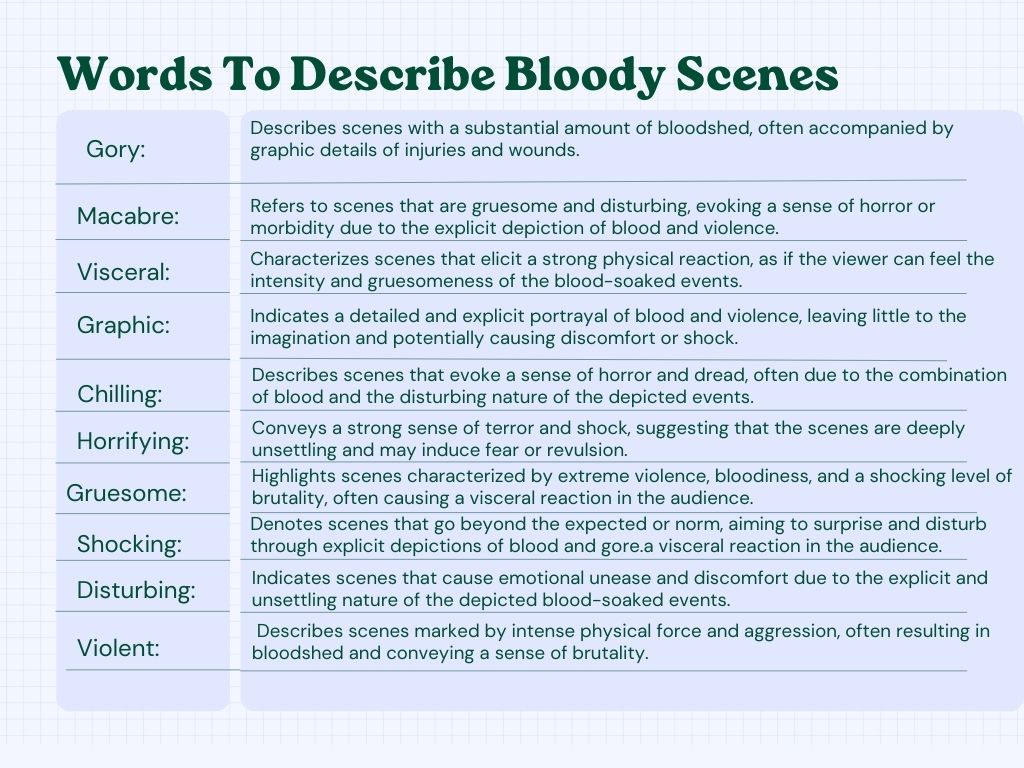How To Describe Blood In Writing (10 Best Steps & Words)
How To Describe Blood In Writing
How To Describe Blood In Writing: In the world of storytelling, the ability to vividly describe blood is a skill that transcends mere words on a page. It is the art of painting emotions, setting the scene, and invoking visceral responses in readers.
Whether it flows as a symbol of life’s vitality or stains as a portent of darkness, blood is a potent narrative element that carries profound cultural and emotional significance.
How we describe it in writing can be the difference between a scene that falls flat and one that resonates deeply with the audience.
In this exploration of how to describe blood in writing, we embark on a journey to unlock the secrets of this evocative literary tool, uncovering the nuances, ethics, and techniques that transform it into a vibrant and unforgettable component of storytelling.
How To Describe Blood In Writing
Describing blood in writing effectively involves engaging the reader’s senses and emotions. Here’s a step-by-step process on How To Describe Blood In Writing:
Observe the Scene
Take a moment to observe the context in which the blood appears. Is it a gruesome crime scene, a medical setting, or a natural occurrence? Understanding the setting will guide your description.
Choose Your Perspective
Decide on the point of view you want to use. First-person and third-person perspectives provide different opportunities for describing blood.
Engage the Senses
Sight: Describe the color, texture, and appearance of the blood. Is it bright red, dark and viscous, or dried and brown? Are there splatters, puddles, or smears?
Smell: Mention any associated odors, which could be metallic, earthy, or acrid, depending on the context.
Sound: If applicable, convey any sounds related to blood, such as dripping, splashing, or the squelching of footsteps.
Emotions and Reactions:
Explore the emotional response of characters or observers to the sight of blood. Are they repulsed, frightened, or fascinated? Show how the presence of blood affects them.
Metaphors and Symbolism
Consider using metaphors or symbolism to convey deeper meanings. For example, blood can symbolize life, death, or passion. It can be described as a river, a stain, or a lifeline.
Contextual Information
Provide context for the presence of blood. Is it a result of violence, injury, childbirth, or a ritual? Understanding why the blood is there adds depth to your description.
Dialogue and Action:
Use dialogue and character actions to reveal more about the situation. What are the characters saying or doing in response to the blood? This can help paint a more vivid picture.
Pacing:
Adjust the pacing of your description based on the intensity of the scene. In a fast-paced, action-packed moment, your description should be concise and impactful. In a slower, more contemplative scene, you can delve into more detail.
Show, Don’t Tell:
Instead of simply stating that there is blood, show it through the reactions, observations, and emotions of your characters. Let readers infer the presence of blood from your descriptions.
Revise and Edit:
After you’ve written your initial description, revisit it during the editing process. Make sure it flows well with the rest of your narrative and that it effectively conveys the desired atmosphere and emotions.
Remember that the way you describe blood should be consistent with the tone and genre of your writing. Whether you’re crafting a horror story, a crime novel, or a romantic scene, the way you depict blood can significantly impact the reader’s experience.

Words To Describe Bloody Scenes
Gory: Describes scenes with a substantial amount of bloodshed, often accompanied by graphic details of injuries and wounds.
Macabre: Refers to scenes that are gruesome and disturbing, evoking a sense of horror or morbidity due to the explicit depiction of blood and violence.
Visceral: Characterizes scenes that elicit a strong physical reaction, as if the viewer can feel the intensity and gruesomeness of the blood-soaked events.
Graphic: Indicates a detailed and explicit portrayal of blood and violence, leaving little to the imagination and potentially causing discomfort or shock.
Chilling: Describes scenes that evoke a sense of horror and dread, often due to the combination of blood and the disturbing nature of the depicted events.
Horrifying: Conveys a strong sense of terror and shock, suggesting that the scenes are deeply unsettling and may induce fear or revulsion.
Gruesome: Highlights scenes characterized by extreme violence, bloodiness, and a shocking level of brutality, often causing a visceral reaction in the audience.
Shocking: Denotes scenes that go beyond the expected or norm, aiming to surprise and disturb through explicit depictions of blood and gore.
Disturbing: Indicates scenes that cause emotional unease and discomfort due to the explicit and unsettling nature of the depicted blood-soaked events.
Violent: Describes scenes marked by intense physical force and aggression, often resulting in bloodshed and conveying a sense of brutality.
The descriptions provided are meant to convey the general meaning of the words and may vary in nuance depending on context.

Understanding the Role of Blood in Writing
Understanding the role of blood in writing is like deciphering the ancient scrolls of storytelling, where every crimson drop carries secrets and symbolism.
Blood isn’t merely a liquid; it’s the ink that writes the hidden stories within our characters’ veins. It’s the visceral brushstroke that paints the canvas of emotions, from the passionate red of love to the ominous black of betrayal.
Blood in writing flows beyond the boundaries of mere description; it’s a narrative river that charts the course of our characters’ destinies, carries the weight of their sins, and mirrors the pulse of their very existence.
To understand blood in writing is to decode the language of life, death, and the complex emotions that bind them, leaving indelible marks on the reader’s imagination.
Symbolism of blood in literature and culture
The symbolism of blood in literature and culture runs deep, staining the pages of history and the tapestry of human understanding with its multifaceted significance.
It is the ancient ink of life, representing both the vitality of existence and the inevitability of mortality. In literature, blood often embodies themes of sacrifice, purity, and redemption, as well as the darker shades of violence, guilt, and corruption.
It can be a symbol of familial bonds, connecting generations, or a marker of division and conflict. Across cultures, blood is a symbol of heritage, a testament to shared ancestry, and a source of identity.
Rituals involving blood, from birth ceremonies to religious rites, underscore its powerful role as a conduit between the physical and the spiritual.
In essence, blood in literature and culture transcends its biological function to become a rich and resonant metaphor, shaping our collective understanding of life’s intricate web of meaning.
Narrative functions of blood
Blood in storytelling serves as a versatile narrative tool, flowing through the veins of literature to perform a multitude of functions.
Like a crimson oracle, it can foreshadow impending doom, its very presence hinting at impending tragedy or transformation.
Blood is also an intimate mirror, reflecting the inner workings of characters’ souls, illuminating their fears, desires, and vulnerabilities.
It sets the emotional tone, coloring scenes with its vivid and visceral imagery, from the exhilaration of victory to the despair of loss.
Blood carries the weight of choices, marking characters with the indelible stain of their actions, making it a potent agent for character development.
Whether as a life force, a catalyst for conflict, or a symbol of profound change, blood in narratives pulsates with significance, infusing stories with depth, complexity, and intrigue.
Ethical considerations when describing blood
When describing blood in literature or any form of creative expression, ethical considerations are paramount. Writers must tread carefully, recognizing the potential impact on readers, particularly those who may have personal experiences or sensitivities related to blood, trauma, or violence.
It is essential to strike a balance between vivid description and gratuitous gore, ensuring that the use of blood serves a legitimate narrative purpose rather than catering solely to shock value.
Authors should also be conscious of cultural and social sensitivities surrounding blood, as it may carry diverse meanings and connotations in different contexts.
Ethical storytelling encourages responsible and empathetic portrayal, with an understanding of how graphic or explicit descriptions may affect readers emotionally.
Ultimately, writers bear a responsibility to handle blood in their narratives with sensitivity, respect, and a mindful consideration of the potential impact on their audience.
Building a Strong Foundation
Building a strong foundation in any endeavor is akin to laying the bedrock of a majestic castle, for it forms the cornerstone of all future aspirations. It’s the blueprint of success, the hidden scaffold upon which dreams are constructed.
Just as a tree’s roots delve deep into the earth to find nourishment, a strong foundation delves into knowledge, planning, and self-awareness.
It’s the compass that guides you through the uncharted wilderness of challenges and opportunities, and the lantern that illuminates your path when darkness looms.
In writing, as in life, a robust foundation ensures that your words resonate, your ideas stand tall, and your narratives soar to the grand heights of literary achievement.
Research and observation
Research and observation form the bedrock upon which the edifice of knowledge and understanding is built. They are the twin lanterns that light the way in our quest for enlightenment and innovation.
Research, with its meticulous exploration of existing information, grants us access to the wisdom of the ages, while observation, through keen and patient perception, reveals the hidden truths of the world around us.
Together, they are the architects of progress, from the laboratory where scientists unlock the secrets of the universe to the library where writers unearth the stories that captivate and inspire.
Through research and observation, we bridge the chasm between the known and the unknown, building bridges to new horizons, unlocking the mysteries of life, and fueling the fires of creativity.
Knowing your audience
Knowing your audience is akin to holding a finely tuned instrument in the world of communication. It’s the compass that guides your message, the key that unlocks engagement, and the bridge that connects hearts and minds.
Just as a skilled musician tailors their performance to captivate a specific audience, effective communication hinges on understanding who you are addressing.
Is your audience young or old, scholars or enthusiasts, novices or experts? What are their interests, values, and expectations? With this knowledge, you can harmonize your words and ideas to resonate deeply, fostering connection and impact.
Whether you seek to inform, persuade, entertain, or inspire, the audience is the North Star guiding your message’s trajectory, and knowing them is the first step toward achieving your communication goals.
Establishing the purpose of blood description
Establishing the purpose of blood description in your writing is akin to sharpening the lens through which your readers perceive your narrative.
It’s the conscious decision that infuses your words with intention and meaning. Are you describing blood to shock your readers, to invoke a visceral emotional response, or to set a tone of foreboding? Is it a symbol of life, death, or transformation within your story’s context? Understanding why you’re incorporating blood into your narrative allows you to wield it as a literary tool, rather than an arbitrary detail.
Like an artist selecting colors for a canvas, defining the purpose of blood description enables you to paint vivid and purposeful strokes across your narrative, enhancing its depth, resonance, and impact on your readers.
Crafting Descriptive Language
Crafting descriptive language is akin to conjuring a symphony of sensations, where words are the notes and sentences are the harmonious arrangements that serenade the senses.
It’s the alchemy of expression, the art of transforming mere ink on paper into a vivid tapestry of imagery that dances in the reader’s mind. Each word becomes a brushstroke, painting pictures that linger in memory, each metaphor a secret door that invites readers into the heart of your narrative.
Crafting descriptive language is the magic wand that turns ordinary descriptions into extraordinary experiences, allowing readers to not just read but to feel, smell, taste, and touch the world you’ve woven with your words.
It’s the power to evoke emotions, ignite imagination, and transport minds to realms both real and fantastical, leaving an indelible mark long after the last page is turned.
Contextualizing Blood Descriptions
Contextualizing blood descriptions is like playing with the prism of perception, where the same crimson hue can convey vastly different meanings based on the narrative landscape it inhabits.
It’s the art of setting the stage, like a director arranging the props and lighting to evoke precisely the desired emotional response from the audience.
Blood’s significance can shift dramatically with the flick of a narrative switch; it can be a symbol of life in a healing scene, a harbinger of danger in a crime scene, or an emblem of passion in a love story.
The contextual magic lies in the subtlety of its transformation, seamlessly adapting to the atmosphere, character perspectives, and genre-specific nuances.
In the hands of a skilled writer, contextualized blood descriptions become the prism through which readers experience the story, casting vibrant, ever-changing hues upon the canvas of their imagination.

Creating the right atmosphere
Creating the right atmosphere in writing is akin to wielding the palette of emotions with your words, painting the backdrop against which your narrative unfolds. It’s the art of weaving sensory details, setting, and mood into a seamless tapestry that envelops your readers.
Whether it’s a moonlit forest draped in mystery, a bustling cityscape pulsing with life, or a dimly lit chamber heavy with foreboding, atmosphere immerses readers in the world you’ve crafted.
It’s the subtle manipulation of language to evoke the desired feelings, allowing readers to not just see and hear, but to breathe in the essence of your story.
The right atmosphere is the stage upon which your characters act, the weather that colors their emotions, and the unseen hand that guides their choices.
In the hands of a skilled writer, it is the secret doorway through which readers willingly step, surrendering to the enchantment of your storytelling.
Genre-specific considerations
Genre-specific considerations in writing are like the unique instruments in an orchestra, each contributing to the symphony of storytelling in its distinct way.
Every literary genre possesses its own set of conventions, expectations, and tropes, akin to the rules and rhythms of a musical genre.
Whether you’re penning a spine-tingling thriller, a heartwarming romance, or a mind-bending science fiction epic, it’s essential to understand and honor the nuances of your chosen genre.
From pacing and character development to tone and thematic elements, genre-specific considerations serve as the compass guiding your narrative journey.
They offer readers a familiar path while also challenging you, the writer, to innovate and subvert expectations. Mastering these considerations allows you to harness the unique power of your chosen genre, captivating your audience with a narrative that resonates authentically within the boundaries of its distinctive world.
Conveying Emotions through Blood
Conveying emotions through blood is like weaving the very heartbeat of humanity into the fabric of storytelling. Blood becomes a living metaphor, coursing with the passions, fears, and desires of your characters.
It’s the crimson ink that inscribes their deepest vulnerabilities, their love’s intensity, and their rage’s unbridled fury upon the pages.
With every drop spilled or shared, you channel emotions so raw they pulse with life. The sight of blood can quicken the reader’s own heartbeat, invoking empathy or dread, and it can transform a scene into a visceral emotional journey.
When words alone fall short, blood serves as the visceral translator of the human experience, allowing readers to connect on a profound level, making them not just observers, but participants in the symphony of emotions you’ve orchestrated.
Exploring character emotions
Exploring character emotions is like embarking on an expedition into the heart’s labyrinth, where each twist and turn reveals a rich tapestry of human experience. It’s the writer’s compass to navigate the complex terrain of a character’s inner world, where joy, sorrow, love, and fear intertwine.
As authors, we become emotional cartographers, mapping the contours of our characters’ souls, and unearthing the buried treasures of their pasts.
Delving into emotions enables us to breathe life into our characters, making them relatable, authentic, and ultimately, unforgettable.
Through their emotional journeys, readers not only witness a story but also embark on their own emotional odyssey, forging profound connections with the characters they encounter along the way.
Using blood to create tension
Using blood to create tension in storytelling is akin to tightening the strings of a suspenseful symphony. It’s the narrative device that keeps readers on the edge of their seats, their hearts pounding in anticipation.
Blood, whether spilled in a crime scene, shed in a conflict, or coursing through veins in a moment of decision, serves as a visceral and potent catalyst.
It introduces an element of risk, of the unknown, and imbues scenes with a sense of urgency. The mere mention of blood can set the narrative pulse racing, signaling impending danger or irrevocable change.
It’s the ink with which writers write the drama of life and death, a tool to manipulate emotion and hold readers in its gripping thrall, ensuring they turn page after page, hungry for resolution, as the tension continues to mount.
Balancing Descriptiveness and Readers’ Comfort
Balancing descriptiveness and readers’ comfort in writing is like walking a tightrope suspended between the dazzling allure of the unknown and the safety of the familiar.
It’s the art of pushing boundaries while maintaining a delicate dance with sensitivity. Words, like a magician’s wand, have the power to conjure vivid and immersive worlds, yet they must be wielded with caution.
Too much detail can overwhelm, alienate, or even distress readers, while too little can leave them feeling disconnected and unengaged.
In this tightrope act, writers must navigate the fine line between evoking emotions and respecting readers’ boundaries.
It’s a quest for the perfect balance, where descriptive precision serves as a bridge between the writer’s imagination and the reader’s comfort zone, ensuring that the journey through the story is as thrilling as it is safe.
Case Studies and Examples
Case studies and examples are the treasure chests of storytelling, akin to a dazzling array of jewels that illuminate the path to understanding.
They are the compelling stories within the story, like secret maps guiding readers through the labyrinth of narrative possibility.
Much like an artist’s sketchbook showcasing a masterpiece in the making, case studies and examples offer readers a glimpse into the inner workings of a writer’s craft.
They illustrate the principles, add depth to the theories, and breathe life into the concepts, transforming abstract ideas into relatable experiences.
These narrative gems are the sparks that ignite the imagination, making the extraordinary accessible and the complex comprehensible.
In their essence, case studies and examples become the lighthouses that illuminate the vast sea of knowledge, making the voyage of discovery not only enlightening but also truly captivating.
Frequently Asked Questions (FAQ) about How To Describe Blood In Writing
What’s the significance of describing blood in writing?
Blood description in writing serves multiple purposes, from setting the mood and atmosphere to conveying emotions, indicating violence, or symbolizing deeper themes.
How can I make blood descriptions more evocative and vivid?
Engage the reader’s senses by using descriptive language, metaphors, and sensory details to create a visceral and emotional connection.
Can I use symbolism when describing blood in writing?
Absolutely! Blood can symbolize various themes like life, death, passion, or even secrets. Using blood symbolically can add depth to your narrative.
What should I consider when describing blood in different contexts, such as medical or crime scenes?
The context matters. In a medical setting, focus on clinical descriptions. In a crime scene, emphasize the gruesome or eerie aspects. Tailor your description to fit the context.
How do I maintain a balance between graphic descriptions and reader comfort?
Consider your target audience and the tone of your story. Graphic descriptions may be suitable for horror but not for all genres. Use discretion to avoid overwhelming readers.
Can I describe blood in a poetic or artistic way?
Certainly! Poetry and artistry can enhance the beauty or intensity of your descriptions. Experiment with figurative language and unique imagery.
What emotions should I convey when describing blood in writing?
The emotions can vary widely depending on the scene. Fear, disgust, fascination, sorrow, or even lust are some possibilities. Choose emotions that fit the narrative.
Should I always use first-person perspective when describing blood in writing?
No, your choice of perspective depends on your narrative style. Third-person can provide objectivity, while first-person can create a more intimate connection with a character’s emotions.
How do I make blood descriptions integral to the plot or character development?
Integrate blood descriptions with character reactions, decisions, and plot progression. Use blood as a tool to drive the story forward or reveal character traits.
Q10: Are there any literary works known for exceptional blood descriptions?
Yes, authors like Stephen King, Edgar Allan Poe, and Cormac McCarthy are known for their skillful and impactful descriptions of blood in various contexts. Studying their works can provide valuable insights.
Remember, there’s no one-size-fits-all approach to describing blood in writing. Adapt your descriptions to suit your narrative goals and engage your readers effectively.
Conclusion
In the conclusion of How To Describe Blood In Writing, the art of describing blood is a potent tool, a symbol, and a narrative anchor that connects readers to the essence of the human experience.
Our journey through the intricacies of describing blood in writing has unveiled its multifaceted nature, from its role as a symbol of life and death to its capacity to evoke emotions and create tension.
We’ve explored the ethical considerations that writers must bear in mind, emphasizing the importance of responsible storytelling.
Armed with the knowledge of how to craft descriptive language, contextualize blood descriptions, and consider genre-specific elements, writers can wield this powerful literary device with precision.
As we conclude this exploration, it’s evident that describing blood in writing is not merely a technical skill but an artistic endeavor, one that allows us to tap into the rich tapestry of human experiences and emotions, leaving indelible marks on the reader’s imagination and connecting us through the ages as storytellers who breathe life into words.






